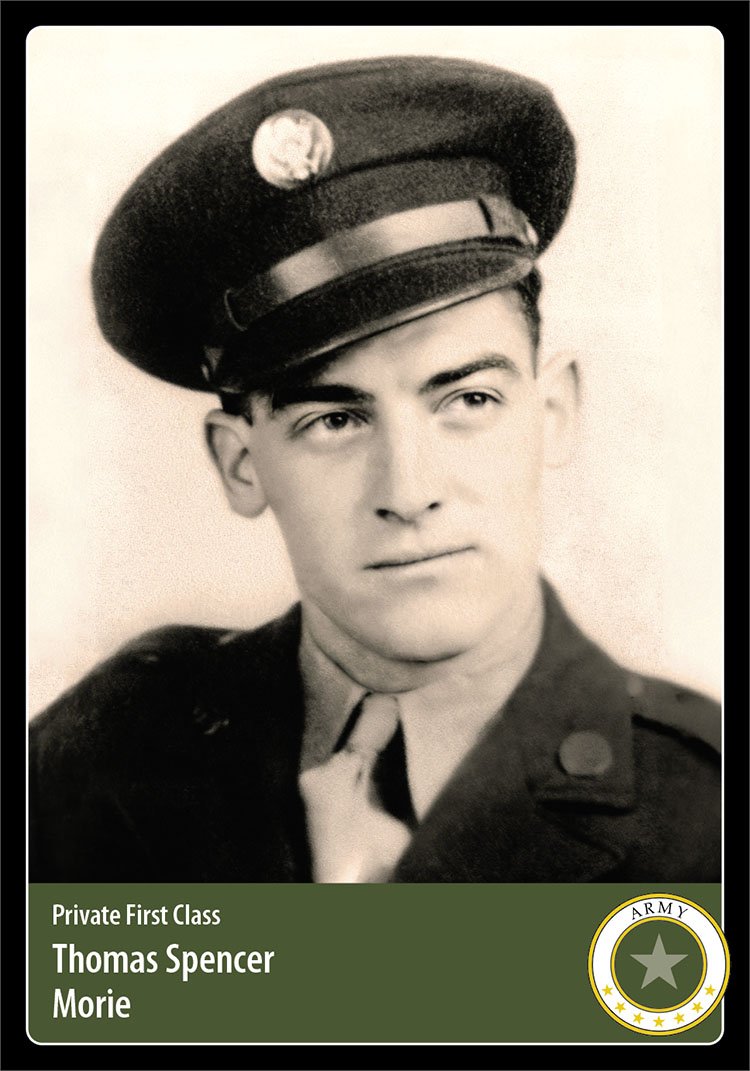Hero Card 225
Photo (digitally restored) provided by the family
Hometown: Dandridge, TN
Branch: U.S. Army
Unit: HQ Company, 3rd Battalion, 376th Infantry Regiment, 94th Infantry Division, Third Army
Date of Sacrifice: February 20, 1945 - KIA in the Saar-Moselle Triangle, Germany
Age: 27
Conflict: World War II, 1939-1945
Thomas “Spencer” Morie grew up in the small town of Dandridge, Tennessee. A half-hour’s drive east of Knoxville, Dandridge is on the shores of Douglas Lake, at the edge of Tennessee’s Great Smokey Mountains.
Spencer was born into a large family on August 23, 1917, as World War I (1914-1918) raged in Europe: parents Charles and Martha (Henderson) Morie, older siblings Arthur, Columbus, Oral, George, Ruth, and—four years later—younger sister Jessie. Spencer attended Green Hill School in Dandridge.
In 1940, Morie married his sister Jessie’s best friend, Georgia Wells. The two would later welcome a son, Gary, and a daughter, Vicki. According to Vicki, “The Wells and Morie families were neighbors in the Green Hill community of Dandridge. My mother [Georgia] was 16 years old and my father [Spencer] 23 years old when they eloped to Kentucky—and kept it secret for several months.”
The Mories were members of Wesley Chapel Methodist Church, west of Dandridge.
Before being drafted into the U.S. Army, Spencer Morie worked for the Tennessee Valley Authority, helping to build the Cherokee and Douglas Dams. The dams were constructed to harness the power of the Holston and French Broad Rivers to provide hydroelectricity to the massive industrial war production effort.
As a second World War broke out in Europe in 1939, America was ill-prepared to fight a war. The U.S. Army ranked 39th in the world, with a cavalry force of 50,000 men using horses to pull their artillery.
Everything would change on December 7, 1941, with a surprise attack by Imperial Japan on the U.S. Pacific fleet at Pearl Harbor, Hawaii. America’s factories would be retooled and brought to bear in a war that would be fought simultaneously across the Pacific and Atlantic oceans.
President Franklin D. Roosevelt said, “It is not enough to turn out just a few more planes, a few more tanks, a few more guns, a few more ships than can be turned out by our enemies. We must out-produce them overwhelmingly, so that there can be no question of our ability to provide a crushing superiority of equipment in any theatre of the world war.”
According to the Ken Burns documentary, The War:
American industry provided almost two-thirds of all the Allied military equipment produced during the war: 297,000 aircraft, 193,000 artillery pieces, 86,000 tanks and two million army trucks. In four years, American industrial production, already the world's largest, doubled in size.
Production at that scale would require energy. To provide the power needed to build America’s war machine, the U.S. government turned to Morie’s employer—the Tennessee Valley Authority. The TVA’s construction of hydroelectric dams would supply electricity for factories that churned out an unprecedented number of airplanes, ships, and bombs.
As American commitment to victory in Europe and the Pacific grew, Spencer Morie was drafted into the United States Army. In 1942 he was sent for Basic Training to Camp Phillips in Salina, Kansas. From there he received additional training at Camp Forrest in Tullahoma, Tennessee, Camp Hulen in Palacios, Texas, and Camp McCain in Elliott, Mississippi before being deployed to Europe.
In late 1944, he was sent to Germany with HQ Company, 3rd Battalion, 376th Infantry Regiment, 94th Infantry Division, Third Army and assigned to the 94th Division’s Army Post Office.
According to the Army Historical Foundation, PFC Morie’s 376th Infantry Regiment:
…entered Germany on 8 January 1945, not long before the conclusion of the Battle of the Bulge. On 19 February, the 376th, was attached to the 10th Armored Division and helped to clear the Saar-Moselle Triangle below Orscholz and Saarburg. On 22 February, after delays caused by a lack of assault boats, heavy German fire, and the loss of COL McClune, who was badly wounded in both legs by shrapnel, the 376th, now under the command of LTC Raynor E. Anderson, crossed the Saar River and established the Ockfen Bridgehead. By 26 February, the 376th had linked up with the 301st and 302nd Infantry, allowing a heavy pontoon bridge to be constructed at Saarburg.
In the Saar-Moselle Triangle, a key battleground along western Germany’s border with France, PFC Morie was killed on February 20, 1945. He was 27 years old.
A little more than two months later, on May 7, 1945, Germany’s Chief of Staff of the German Army signed an unconditional surrender at Gen. Dwight D. Eisenhower’s headquarters.
PFC Thomas Spencer Morie is buried near his hometown. His name is inscribed at the East Tennessee Veterans Memorial in Knoxville (Pillar XII, Middle Panel).
Sources
Details submitted by Major General (retired) Leslie Purser, Ms. Vicki Kesterson, PFC Morie’s daughter and Todd Kesterson, PFC Morie’s grandson.
The Knoxville News-Sentinel, August 28, 1948: Morie, PFC. Thomas S.
East Tennessee Veterans Memorial Association: Thomas S. Morie
Honor States: Thomas S Morie
Jefferson County Tourism: The Building of the Dams
Tennessee Valley Authority: The 1940s
PBS—Ken Burns, The War: War Production
The Army Historical Foundation: 376th Infantry Regiment
Burial Site: Find a Grave
Educate future generations, instill gratitude, honor the fallen. Join the Mission!





